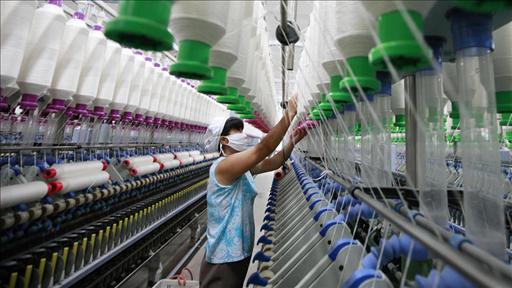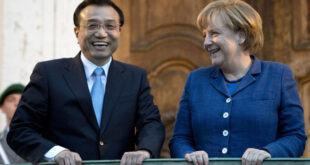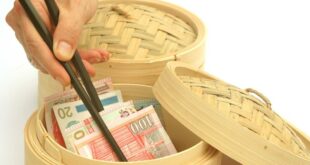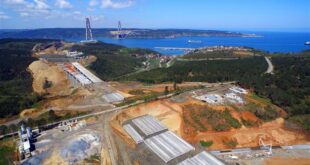A stronger reading for a Chinese manufacturing gauge failed to end predictions for policy loosening as analysts described the gain as seasonal and a separate survey showed exporters struggling.
A Purchasing Managers’ Index (CPMINDX) rose to a one-year high of 53.1 in March, China’s logistics federation and the National Bureau of Statistics said yesterday. The gauge has a pattern of rising each March. In contrast, a PMI from HSBC Holdings Plc and Markit Economics showed manufacturing contracting and export orders falling.
Premier Wen Jiabao has pledged to “fine-tune” economic policies as needed as weakness in export demand and a cooling housing market restrain an economy that probably grew at the slowest pace in almost three years in the first quarter. Analysts in a Bloomberg News survey last week unanimously said that banks’ reserve requirements will fall this year, while nine of 20 predicted lower benchmark borrowing costs.
“Policy easing is still needed to avoid a hard landing,” said Shen Jianguang, a Hong Kong-based economist for Mizuho Securities Asia Ltd., who previously worked for the International Monetary Fund and European Central Bank. Fiscal spending will be “the driving force” and more cuts in bank reserve requirements are needed, he said.
The Shanghai Composite Index has dropped about 9 percent from this year’s high on Feb. 27 on concern that the world’s second-biggest economy is faltering, while the yuan was little changed in the first quarter at 6.2980 per dollar.
‘Purely Seasonal’
Bank of America Corp. economist Lu Ting yesterday predicted two cuts by year-end in the proportion of deposits that lenders are required to set aside as reserves, a ratio now at 20.5 percent for the biggest lenders, such as Industrial & Commercial Bank of China Ltd. The government may step up the construction of low-cost housing and the central bank could encourage lenders to reduce rates for loans, including mortgages, he said.
“The rebound in the government PMI is purely seasonal,” said Joy Yang, chief China economist at Mirae Asset Securities (HK) Ltd., who previously worked at the IMF. “Flexible and paced easing” is needed, she said.
The government-backed PMI is skewed toward large enterprises and affected by seasonality, with the gauge climbing an average of 3.2 points each March from 2005 to 2011 as production returned to normal after a Lunar New Year holiday, HSBC said in a note. The latest number was higher than analysts’ median estimate of 50.8.
Export Weakness
The HSBC and Markit data indicated that export orders fell for a second month. At UBS AG, Hong Kong-based economist Wang Tao said that logistics federation data also showed a decline if seasonally adjusted.
“As inflation pressures continue to ease, weaker export growth is likely to prompt further easing measures,” said Qu Hongbin, a Hong Kong-based economist for HSBC. “Once the easing measures filter through, growth is likely to start bottoming out in the second quarter and rebound modestly in the second half.”
HSBC forecasts reserve-ratio cuts of at least 1 percentage point in the first half as well as additional tax breaks and fiscal spending, Qu said.
In a statement released March 31, the central bank reaffirmed a “prudent” monetary stance and said that economic growth is stable and Europe’s debt crisis is easing. Wen pared this year’s expansion target to 7.5 percent from an 8 percent goal in place since 2005, he announced March 5 at the legislature’s annual conference.
Trade Shortfall
China had its largest trade deficit since at least 1989 in February as Europe’s sovereign-debt turmoil damped exports and imports rebounded after the weeklong holiday. Exports fell for the first time in two years in January.
Mixed signs for the economy last week ranged from ICBC reporting higher-than-estimated net income for the fourth quarter, widening the bank’s lead as the world’s most profitable lender, to a slide in industrial companies’ profits.
Morgan Stanley joined Nomura Holdings Inc. and Deutsche Bank AG (DBK) in raising its forecast for China’s economic growth this year even as Societe Generale SA told clients to expect a slump in corporate profits. The world’s second-biggest economy will expand 9 percent, higher than a previous estimate of 8.4 percent, said Helen Qiao, a Morgan Stanley economist.
Such projections, still below last year’s 9.2 percent rate, offer little comfort for Australian mining company BHP Billiton Ltd. (BHP), seeing slower steel production in China, or German automaker Daimler AG (DAI), whose Mercedes dealers in the nation are giving record discounts.
Steel, Iron Ore
Curbs on property sales and plans to tilt the economy toward consumption and away from a dependence on capital spending have reduced production of steel and cement and helped push down iron-ore prices. Prices of new apartments fell in 45 of 70 major cities in February from January, according to government data.
Gross domestic product probably expanded 8.4 percent in the first quarter from a year earlier, according to the median estimate of analysts surveyed by Bloomberg, down from 8.9 percent in the fourth quarter.
The logistics federation’s PMI “indicates that economic growth is in an apparent rebound state,”Zhang Liqun, a senior researcher at the Development Research Center of the State Council, said in a statement. At the same time, the expansion may still slow based on market demand, Zhang said.
Source: Bloomberg
 Asia Finance News Asia finance news, banking, market analysis, business, Forex, trade, Cryptocurrency as it is happening in Asia. Trusted gateway for Asian financial news.
Asia Finance News Asia finance news, banking, market analysis, business, Forex, trade, Cryptocurrency as it is happening in Asia. Trusted gateway for Asian financial news.





